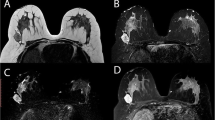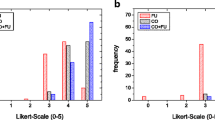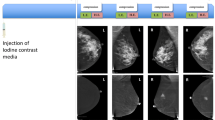Abstract
Objective
This study was performed to assess the sensitivity and specificity for malignant and benign mass lesions of a diagnostic approach combining DWI with T2-weighted images (unenhanced MR mammography, ueMRM) and compare the results with contrast-enhanced MR mammography (ceMRM).
Materials and methods
Consecutive patients undergoing histopathological verification of mass lesions after MR mammography without prior breast interventions (contrast-enhanced T1-weighted, T2-weighted and DWI sequences) were eligible for this retrospective investigation. Two blinded observers first rated ueMRM and then ceMRM according to the BIRADS scale. Lesion size, ADC values and T2-weighted TSE descriptors were assessed.
Results
This study examined 81 lesions (27 benign, 54 malignant). Sensitivity of ueMRM was 93% (observer 1) and 86% (observer 2), respectively. Sensitivity of ceMRM was 96.5% (observer 1) and 98.3% (observer 2). Specificity was 85.2% (ueMRM) and 92.6% (ceMRM) for both observers. The differences between both methods and observers were not significant (P ≥ 0.09). Lesion size measurements did not differ significantly among all sequences analyzed. Tumor visibility was worse using ueMRM for both benign (P < 0.001) and malignant lesions (P = 0.004).
Conclusion
Sensitivity and specificity of ueMRM in mass lesions equal that of ceMRM. However, a reduced lesion visibility in ueMRM may lead to more false-negative findings.




Similar content being viewed by others
References
Kuhl C (2007) The current status of breast MR imaging. Part I. Choice of technique, image interpretation, diagnostic accuracy, and transfer to clinical practice. Radiology 244:356–378
Kuhl CK (2007) Current status of breast MR imaging. Part 2. Clinical applications. Radiology 244:672–691
Kuhl CK, Schrading S, Weigel S et al (2005) [The “EVA” Trial: Evaluation of the efficacy of diagnostic methods (mammography, ultrasound, MRI) in the secondary and tertiary prevention of familial breast cancer. Preliminary results after the first half of the study period]. Rofo 177:818–827
Leach MO, Boggis CR, Dixon AK et al (2005) Screening with magnetic resonance imaging and mammography of a UK population at high familial risk of breast cancer: a prospective multicentre cohort study (MARIBS). Lancet 365:1769–1778
Agarwal R, Brunelli SM, Williams K et al (2008) Gadolinium-based contrast agents and nephrogenic systemic fibrosis: a systematic review and meta-analysis. Nephrol Dial Transplant doi:10.1093/ndt/gfn593
Bellin MF, Van Der Molen AJ (2008) Extracellular gadolinium-based contrast media: an overview. Eur J Radiol 66:160–167
Baltzer PA, Renz DM, Herrmann KH et al (2009) Diffusion-weighted imaging (DWI) in MR mammography (MRM): clinical comparison of echo planar imaging (EPI) and half-Fourier single-shot turbo spin echo (HASTE) diffusion techniques. Eur Radiol doi:10.1007/s00330–009–1326–5
Guo Y, Cai YQ, Cai ZL et al (2002) Differentiation of clinically benign and malignant breast lesions using diffusion-weighted imaging. J Magn Reson Imaging 16:172–178
Hatakenaka M, Soeda H, Yabuuchi H et al (2008) Apparent diffusion coefficients of breast tumors: clinical application. Magn Reson Med Sci 7:23–29
Kinoshita T, Yashiro N, Ihara N et al (2002) Diffusion-weighted half-Fourier single-shot turbo spin echo imaging in breast tumors: differentiation of invasive ductal carcinoma from fibroadenoma. J Comput Assist Tomogr 26:1042–1046
Kuroki Y, Nasu K, Kuroki S et al (2004) Diffusion-weighted imaging of breast cancer with the sensitivity encoding technique: analysis of the apparent diffusion coefficient value. Magn Reson Med Sci 3:79–85
Kuroki-Suzuki S, Kuroki Y, Nasu K et al (2007) Detecting breast cancer with non-contrast MR imaging: combining diffusion-weighted and STIR imaging. Magn Reson Med Sci 6:21–27
Luo JD, Liu YY, Zhang XL et al (2007) [Application of diffusion weighted magnetic resonance imaging to differential diagnosis of breast diseases]. Ai zheng = Aizheng = Chinese Journal of Cancer 26:168–171
Marini C, Iacconi C, Giannelli M et al (2007) Quantitative diffusion-weighted MR imaging in the differential diagnosis of breast lesion. Eur Radiol 17:2646–2655
Matsuoka A, Minato M, Harada M et al (2008) Comparison of 3.0-and 1.5-tesla diffusion-weighted imaging in the visibility of breast cancer. Radiat Med 26:15–20
Park MJ, Cha ES, Kang BJ et al (2007) The role of diffusion-weighted imaging and the apparent diffusion coefficient (ADC) values for breast tumors. Korean J Radiol 8:390–396
Rubesova E, Grell AS, De Maertelaer V et al (2006) Quantitative diffusion imaging in breast cancer: a clinical prospective study. J Magn Reson Imaging 24:319–324
Wenkel E, Geppert C, Schulz-Wendtland R et al (2007) Diffusion weighted imaging in breast MRI: comparison of two different pulse sequences. Acad Radiol 14:1077–1083
Woodhams R, Matsunaga K, Iwabuchi K et al (2005) Diffusion-weighted imaging of malignant breast tumors: the usefulness of apparent diffusion coefficient (ADC) value and ADC map for the detection of malignant breast tumors and evaluation of cancer extension. J Comput Assist Tomogr 29:644–649
Woodhams R, Matsunaga K, Kan S et al (2005) ADC mapping of benign and malignant breast tumors. Magn Reson Med Sci 4:35–42
Charles-Edwards EM, deSouza NM (2006) Diffusion-weighted magnetic resonance imaging and its application to cancer. Cancer Imaging 6:135–143
Kuroki Y, Nasu K (2008) Advances in breast MRI: diffusion-weighted imaging of the breast. Breast cancer (Tokyo, Japan) 15:212–217
Ikeda DM, Hylton NM, Kuhl CK et al (2003) MRI breast imaging reporting and data system atlas, 1st edn. American College of Radiology, Reston
Malich A, Fischer DR, Wurdinger S et al (2005) Potential MRI interpretation model: differentiation of benign from malignant breast masses. AJR 185:964–970
Altman DG, Bland JM (1994) Diagnostic tests. 1: Sensitivity and specificity. BMJ 308:1552
Altmann DG (1991) Practical statistics for medical research. Chapman & Hall, New York
Liberman L, Morris EA, Lee MJ et al (2002) Breast lesions detected on MR imaging: features and positive predictive value. AJR 179:171–178
Tozaki M, Fukuda K (2006) High-spatial-resolution MRI of non-masslike breast lesions: interpretation model based on BI-RADS MRI descriptors. AJR 187:330–337
Chen G, Jespersen SN, Pedersen M et al (2005) Intravenous administration of Gd-DTPA prior to DWI does not affect the apparent diffusion constant. Magn Reson Imaging 23:685–689
Fitzek C, Mentzel HJ, Fitzek S et al (2003) Echoplanar diffusion-weighted MRI with intravenous gadolinium-DTPA. Neuroradiology 45:592–597
Yamada K, Kubota H, Kizu O et al (2002) Effect of intravenous gadolinium-DTPA on diffusion-weighted images: evaluation of normal brain and infarcts. Stroke 33:1799–1802
Yuen S, Yamada K, Goto M et al (2009) Microperfusion-induced elevation of ADC is suppressed after contrast in breast carcinoma. J Magn Reson Imaging 29:1080–1084
Author information
Authors and Affiliations
Corresponding author
Electronic supplementary material
Below is the link to the Electronic supplementary material
Supplemental material 1
(DOC 32.5 KB)
Rights and permissions
About this article
Cite this article
Baltzer, P.A.T., Benndorf, M., Dietzel, M. et al. Sensitivity and specificity of unenhanced MR mammography (DWI combined with T2-weighted TSE imaging, ueMRM) for the differentiation of mass lesions. Eur Radiol 20, 1101–1110 (2010). https://doi.org/10.1007/s00330-009-1654-5
Received:
Revised:
Accepted:
Published:
Issue Date:
DOI: https://doi.org/10.1007/s00330-009-1654-5




